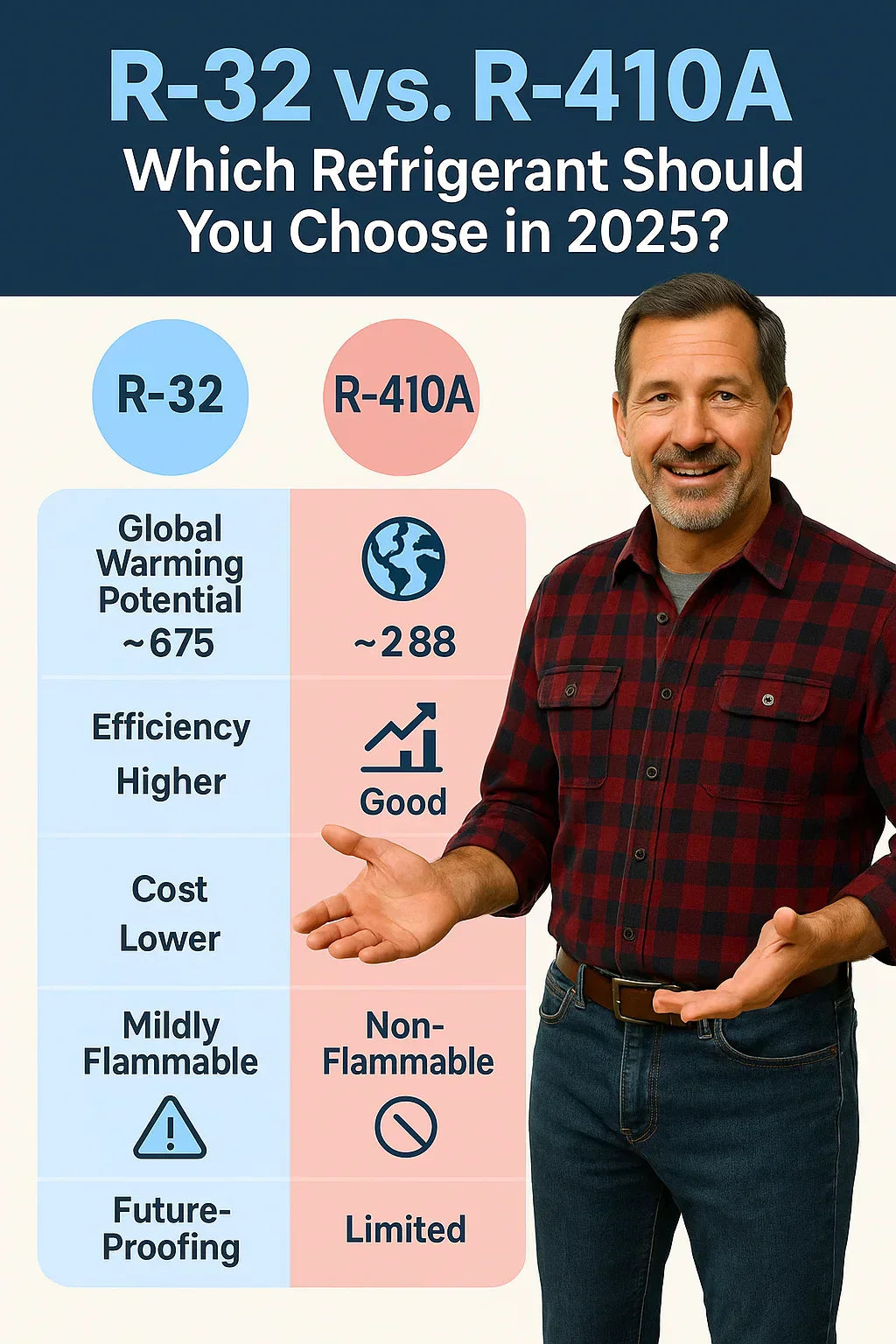❄️ 1. Introduction: Why Refrigerant Choice Matters in 2025
By early 2025, the HVAC industry enters a major turning point: the EPA mandates that new residential HVAC systems use refrigerants with a Global Warming Potential (GWP) of 700 or lower
That means the era of R-410A—a non-ozone-depleting but high-GWP HFC—is ending for new installs, while lower-GWP alternatives like R‑32 and R‑454B are becoming the new standard
For homeowners like Mike, refrigerant choice impacts more than just the planet. It affects:
-
Energy efficiency and operating costs
-
System design, weight, and sound
-
Serviceability and future maintenance
-
Compliance with regulations and eligibility for rebates
Let’s walk through the key differences and figure out which refrigerant makes the most sense if you’re replacing or installing a new AC in 2025.
⚙️ 2. Understanding R‑410A and R‑32
🔹 R‑410A: Former Industry Standard
A blend of difluoromethane (R‑32) and pentafluoroethane (R‑125), R‑410A has been used in most residential AC systems for decades. It’s non-flammable (A1), stable, and widely understood by technicians—but it has a very high GWP of ~2088
🔹 R‑32: The New Preferred Choice
R‑32 is a single-component refrigerant, not a blend, with much better thermodynamic properties. It’s classified as A2L, meaning mildly flammable but low toxicity. Importantly, its GWP is ~675, a ~67–70% reduction compared to R‑410A
🌱 3. Environmental Impact: Who Wins on GWP?
Choose R‑32 and you're cutting global warming potential in half relative to R‑410A. That's why EPA’s HFC phasedown under the AIM Act starts enforcing alternatives with GWP ≤ 700 in 2025
Over the next decade, R‑410A availability tightens, and reclaimed refrigerant becomes required and more expensive—making R‑32 a more sustainable and compliant option
⚡ 4. Efficiency & Performance: R‑32 Pulls Ahead
🔍 Better Heat Transfer & SEER2 Ratings
Because R‑32 transfers heat more efficiently per pound and operates at slightly lower mass flow, it typically provides 5–10% higher SEER2 ratings than equivalent R‑410A systems
Mike’s own experience is backed by Daikin and ANSI/ASHRAE data—cleaner cooling, shorter compressor runtimes, and improved real-world savings
🔁 Lower Refrigerant Volume & Smarter Operation
R‑32 needs 20–30% less refrigerant charge than R‑410A, reducing stress on the system and improving leak tolerance
It pairs well with inverter and variable-speed systems, running smoothly at partial loads to deliver stable efficiency and quieter operation
💰 5. Cost Considerations in 2025
💸 Upfront Cost vs. Long-Term Value
R‑32 systems may cost slightly more upfront—but not always. Because they use less refrigerant, they may actually be cheaper per unit to produce long term
Meanwhile, R‑410A supply is tightening, pushing prices up for both equipment and service refrigerant
💲 Operating Savings
In practical terms, switching from a 14 SEER2 R‑410A system to a ~15.2 SEER2 R‑32 setup can save $50–$100+ per year in cooling bills for a mid-sized home
Over a typical 15‑year life, that adds up to hundreds—even over a thousand dollars compared to older equipment.
🛠️ 6. Maintenance, Safety & Service
🔒 Safety: A2L vs. A1
R‑32’s classification as A2L (mildly flammable) means installations must follow stricter safety protocols—but that’s standard for all post-2025 systems. With certified technicians and proper ventilation, it’s very safe
🔧 Maintenance & Servicing
Because R‑32 is a single-component refrigerant—not a mix—it is easier to top off and reclaim with less risk of performance issues
However, you cannot retrofit an R‑410A system to R‑32—you must install a matched R‑32 system built for that refrigerant, with compatible coils and gauges
📜 7. Regulations & Timeline
Here’s a high-level regulatory timeline to keep in mind:
-
Jan 1, 2025: EPA mandates refrigerant GWP ≤ 700 in all new residential HVAC/heat pump systems
-
2028–2036: Further phasedown cuts of up to 85% under the AIM Act
-
Post-2025: R‑410A producers and stockpiles are gradually depleted; reclaimed usage increases and cost rises
Bottom line: Installing R‑32 in 2025 avoids future supply risk and ensures compliance—while R‑410A systems will face shrinking availability and rising service costs.
🏡 8. Mike’s Take: Which Should You Choose in 2025?
✅ If You’re Installing a New HVAC System in 2025
Pick R‑32. You get stronger efficiency, lower emissions, better eligibility for rebates, and future-proof compliance. It’s becoming the standard for good reason.
🛠️ If You Already Have an R‑410A System
No rush. Continue regular maintenance and plan ahead. When it's time to replace, transition to R‑32 for a smoother upgrade path.
💡 Key Reminders for Homeowners
-
Ask your installer to verify that system components are designed specifically for R‑32, not legacy R‑410A parts.
-
Confirm they’re A2L-certified and using the proper tools (leak sensors, ventilation checks, manifold hoses rated for A2L).
-
Watch for local and manufacturer rebates on R‑32 systems—they’re becoming common.
📊 9. Quick Comparison Table
| Feature | R‑410A | R‑32 |
|---|---|---|
| GWP | ~2,088 | ~675 (67–70% lower) |
| Efficiency (SEER2) | 13.4–18.0 | 14.3–17.0+, often 5–10% better |
| Refrigerant Volume | Higher | 20–30% less needed |
| Flammability Rating | A1 (non-flammable) | A2L (low flammability) |
| Cost per Pound | Rising due to scarcity | Lower, and decreasing |
| Service & Maintenance | Established, wide availability | More efficient, easier to reclaim |
| Regulatory Compliance | Phasing out | Fully compliant with 2025+ mandates |
🌟 10. Final Verdict
For most homeowners—and particularly those installing new systems in 2025—R‑32 is the clear choice. It delivers better efficiency, lower environmental impact, and regulatory compliance, all while staying ahead of rising R‑410A costs.
If you're still on R‑410A today, that’s OK. But for your next purchase, switch to R‑32—and make sure your installer is certified to handle A2L refrigerants safely.
In the next topic we will read more about: Single-Stage vs. Two-Stage 3-Ton AC Systems: Which Fits Your Budget and Comfort Goals?







